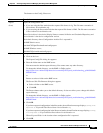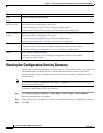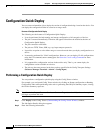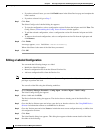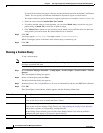
8-49
User Guide for Resource Manager Essentials 4.1
OL-11714-01
Chapter 8 Archiving Configurations and Managing Them Using Archive Management
Configuring Labels
• Change the Label Description. You can enter up to 128 characters.
• Select a configuration version file from the left pane, click Add to add the selected configuration
file.
–
If you selected Latest in the previous dialog box, the left pane will show devices and the latest
archived configuration file. The right pane contains labeled configuration.
–
If you selected All in the previous dialog box, the left pane will show devices and all available
archived configuration files. The right pane contains labeled configuration.
Note You can select only one configuration file for a device.
• To remove the selected configuration, select a configuration version file from the right pane and
click Remove.
• To view the configuration, select a configuration version file from the left pane and click View. The
Config Viewer (
Understanding the Config Viewer Window) window appears.
Step 7 Click Finish.
A message appears, Label LabelName updated.
Where LabelName is the name of the label as entered by you.
Step 8 Click OK.
Viewing the Labeled Configuration
You can view configurations of a label from the label listing.
Note View Permission Report (Common Services > Server > Reports) to check if you have the required
privileges to perform this task.
Step 1 Select Resource Manager Essentials > Config Mgmt > Archive Mgmt > Label Configs.
The Label Configs dialog box appears.
Step 2 Select a label and click View.
The Label Config Viewer window appears with the following information:
Column Name Description
Device Name Device Display Name as entered in Device and Credential Repository.
Config Type Defines the type of configuration PRIMARY, SECONDARY, or VLAN.
• PRIMARY/SECONDARY—Contains the Running and Startup configuration files information.
• VLAN—Contains running vlan.dat configuration file information. This configuration type does
not contain Startup configuration file information.
For ONS devices, the PRIMARY configuration type displays the configuration information from the
active CPU, at that instance.



